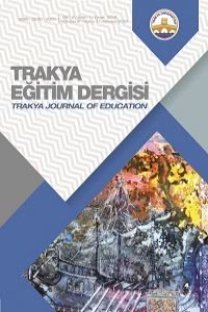Ortaokul Öğrencilerinin Yapılandırmacı Öğrenme Ortamı Algıları ve Derse Katılımlarının Demografik Değişkenler Açısından İncelenmesi
Yapılandırmacı öğrenme ortamı, derse katılım, fen bilimleri
Investigation of the Perception of Constructivist Learning Environment and Classroom Engagement in Relationship in Terms of Demographic Variables of Middle School Students
___
- Appleton, J. J., Christenson, S. L., Kim, D., & Reschly, A. L. (2006). Measuring cognitive and psychological engagement instrument. Journal of School Psychology, 44, 427-445.
- Aygören, F. (2009). Yapılandırmacı öğrenme ortamlarının sınıf öğretmenlerinin ve okul yöneticilerinin görüşlerine göre değerlendirmesi. Yayımlanmamış Yüksek Lisans Tezi, Adnan Menderes Üniversitesi Sosyal Bilimler Enstitüsü, Aydın.
- Baş, G. (2012). İlköğretim öğrencilerinin yapılandırmacı öğrenme ortamına ilişkin algılarının farklı değişkenler açısından değerlendirilmesi. Eğitim ve Öğretim Araştırmaları Dergisi, 1(4), 203-215.
- Brumbaugh, D. K., & Rock, D. (2006) Teaching Secondary Mathematics, Routledge: London.
- Çavuş, R., & Yılmaz, M. M. (2014). Ortaokul öğrencilerinin fen ve teknoloji dersindeki yapılandırmacı öğrenme ortamına ilişkin görüşlerinin farklı değişkenlere göre incelenmesi. Fen Eğitimi ve Araştırmaları Derneği Fen Bilimleri Öğretimi Dergisi, 2(2), 110-128.
- Çınar, O., Temel, A., Beden, N., & Göçgen, S. (2004, Temmuz). Kalabalık sınıfların öğretmen ve öğrenciye etkisi. XIII. Ulusal Eğitim Bilimleri Kurultayı, İnönü Üniversitesi, Malatya.
- Demirel, Ö. (2005). Eğitimde program geliştirme: kuramdan uygulamaya. Ankara: Pegem A Yayıncılık, 7. Baskı.
- Erdoğan, İ., & Polat, M. (2017). Okullarımız yapılandırmacı öğrenme ortamlarına ne kadar sahip? Ortaokul öğrencilerinin algıları üzerine boylamsal bir bakış. Dicle Üniversitesi Ziya Gökalp Eğitim Fakültesi Dergisi, 30, 608-619.
- Fredricks, J. A., Blumenfeld, P. C., & Paris, A. H. (2004). School engagement: Potential of the concept, state of the evidence. Review of Educational Research, 74(1), 59-109.
- Gravetter, J. F., & Forzano, L. B. (2012). Research methods for the behavioral sciences (4. Baskı). USA: Linda Schreiber-Ganster.
- Güvenç, H. (2015). Etkin katılım ölçeği geliştirme ve uyarlama çalışması. Ahi Evran Üniversitesi Kırşehir Eğitim Fakültesi Dergisi (KEFAD). 1(16), 255-267.
- Jonassen, D. H., & Land, S. M. (2000) Theoretical foundations of learning environments, Lawrence Erlbaum Associates: New Jersey.
- Kalem, S., & Fer, S. (2003). Aktif öğrenme modeliyle oluşturulan öğrenme ortamının öğrenme, öğretme ve iletişim sürecine etkisi. Kuram ve Uygulamada Eğitim Bilimleri, 3(2), 433-461.
- Karasar, N. (2009). Bilimsel araştırma yöntemleri. Ankara: Nobel yayınları.
- Klem, A. M., & Connell, J. P. (2004). Relationships matter: Linking teacher support to student engagement and achievement. Journal of School Health, 74, 262-273.
- Köseoğlu, F., & Kavak N. (2001). Fen öğretiminde yapılandırıcı yaklaşım. Gazi Üniversitesi Gazi Eğitim Fakültesi Dergisi, 21(1).
- Li, Y., & Lerner, R. M. (2013). Interrelations of behavioral, emotional, and cognitive school engagement in high school students. Journal of Youth and Adolescence, 42(1), 20-32.
- Nayman, Ö. (2011). Fen ve teknoloji dersindeki öğrenme ortamının yapılandırmacılığa dayalı olarak değerlendirilmesi, (Yayımlanmamış yüksek lisans tezi), Eskişehir Osmangazi Üniversitesi, Eskişehir.
- Newmann, F., Wehlage, G. G., & Lamborn, S. D. (1992). The significance and sources of student engagement. Chapter in (F. Newmann, Ed.), Student engagement and achievement in American secondary schools (11-39). New York: Teachers College Press.
- Özkal, K., Tekkaya, C., Çakıroğlu, J., & Sungur, S. (2009). A conceptual model of relationships among constructivist learning environment perceptions, epistemological beliefs, and learning approaches. Learning and Individual Differences, 19(1), 71-79.
- Perkins, D. N. (1999). The many faces of constructivism. &iucational Leadership, Nov., 6-11.
- Pınar Bal, A., & Doğanay, A. (2009). İlköğretim beşinci sınıf öğrencilerinin matematik dersinde yapılandırmacı öğrenme ortamına bakış açıları. Çukurova Üniversitesi Sosyal Bilimler Enstitüsü Dergisi, 18(2), 156-171.
- Raftery, J. N., Grolnick, W. S., & Flamm, E. S. (2012). Families as facilitators of student engagement: Toward a home-school partnership model. In S. J. Christenson, A. L. Reschlyve C. Wylie (Eds.), Handbook of research on student engagement (pp. 343-364). NY: Springer.
- Reeve, J. (2012). A self-determination theory perspective on student engagement. In S. J. Christenson, A. L. Reschlyve C. Wylie (Eds.), Handbook of research on student engagement (pp. 149-172). NY: Springer.
- Reeve, J. (2013). How students create motivationally supportive learning environments for themselves: The concept of agentic engagement. Journal of Educational Psychology, 105, 579-595. doi:10.1037/a0032690
- Reeve, J., & Tseng, C. (2011). Agency as a fourth aspect of students’ engagement during learning activities. Contemporary Educational Psychology, 36(4), 257-267.Saracaloğlu, A. S., Akamca, G. Ö., & Yesildere, S. (2006) “İlköğretimde Proje Tabanlı Öğrenmenin Yeri”, http://www.tebd.gazi.edu.tr/arsiv/2006_cilt4/ sayi_3/241-260.pdf.
- Selley, N. (1999). The art of constructivist teaching in the primary school. David Fulton Publishers, London.
- Slavin, R. (1997). Cooperative learning theory, resarch and practice. Englewood Cliffs. NJ: Prentice Hal.
- Şaşan H. H. (2002). Yapılandırmacı öğrenme. Yaşadıkça Eğitim. 74 – 75.
- Yavuz, M., Gülmez, D., & Özkaral, T. (2016). Fen lisesi öğrencilerinin akademik başarıları ile ilgili deneyimlerinin değerlendirilmesi. Kastamonu Eğitim Dergisi, 24(4), 1655-1672.
- Zhang, L. J. (2008). Constructivist pedagogy in strategic reading instruction: Exploring pathways to learner development in the English as a second language (ESL). Instructional Science, 36, 89-116.
- Zorlu, Y., & Zorlu, F. (2015). Fen ve teknoloji dersinde öğrenme ortamına yönelik öğrencilerin düzeyleri ve öğretmenlerin görüşleri. Route Educational and Social Science Journal, 2(1), 103-114.
- ISSN: 2630-6301
- Yayın Aralığı: Yılda 3 Sayı
- Başlangıç: 2011
- Yayıncı: Trakya Üniversitesi Eğitim Fakültesi
Çocuklara İngilizce Öğretiminde Kart Sihirbazlıklarının Kullanımı Üzerine Görüşler
Destekleme ve Yetiştirme Kurslarına (DYK) İlişkin Ortaokul Öğrencilerinin Görüşleri
Serkan TİMUR, Sakıp KAHRAMAN, Betül TİMUR, Ayfer İŞSEVEN
Öğretmen Adaylarının Medya Okuryazarlık Düzeyleri
Algılanan Müdür Yönetim Tarzı ve İçsel Motivasyonun Öğretmenlerin Örgütsel Bağlılığına Etkisi
Seyfettin ABDURREZZAK, Mehmet ÜSTÜNER
Çocuklara İngilizce Öğretiminde Kart Sihirbazlıklarının Kullanımı
Dolaylı veya Doğrudan Düzeltme Geribildirimi: Bir Eylem Araştırması
Türkçe Dersi Öğretim Programlarının Karşılaştırmalı Analizi (2009-2017-2019)
Nurdan KALAYCI, Nilay YILDIRIM
A Case Study: Literacy Experiences of Struggling Readers with Interactive Digital Books
